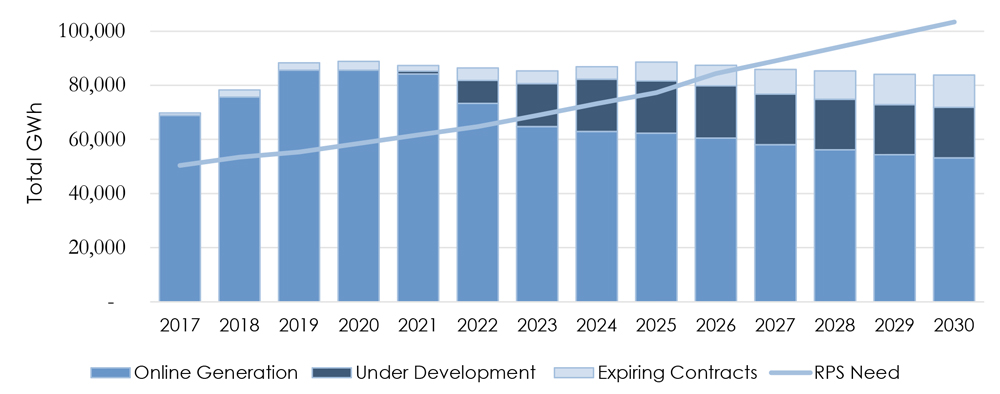California’s three large investor-owned utilities are on track to meet the state’s goal of serving retail customers with 60% renewable energy by 2030, but some smaller utilities and community choice aggregators (CCAs) are lagging, a report issued Friday by the California Public Utilities Commission concluded.
The CPUC’s annual report on the state’s renewable portfolio standard assessed the progress made by electricity retailers — IOUs, CCAs, small and multijurisdictional utilities (SMJUs) and electric service providers (ESPs) — on procuring 33% of energy from renewable sources by 2020 and 60% by 2030, as well as interim periodic goals.
The CPUC and the California Energy Commission oversee the state’s RPS program, the most ambitious in the nation. CPUC-jurisdictional load-serving entities serve approximately 75% of in-state load.
Senate Bill SB 100, signed by former Gov. Jerry Brown in 2018, established the 60%-by-2030 mandate, as well as the requirement that all retail customers be supplied with 100% carbon-free energy by 2045.
“As of 2021, the investor-owned utilities have executed renewable electricity contracts necessary to meet 2021 RPS requirement and are forecasted to have excess renewable procurement through 2027,” the CPUC said in a statement. “The small and multijurisdictional utilities, electric service providers and community choice aggregators collectively need to procure additional renewable resources to meet the 2021-2024 compliance period requirements, as well as future requirements.”
 Combined progress of utilities toward meeting the state’s 60%-by-2030 renewables goal. | CPUC
Combined progress of utilities toward meeting the state’s 60%-by-2030 renewables goal. | CPUCThe IOUs — Pacific Gas and Electric (NYSE:PCG), Southern California Edison (NYSE:EIX) and San Diego Gas & Electric (NYSE:SRE) — are expected to “continue to surpass RPS requirements as they are forecasted to have excess procurement for the next seven years,” the report said. “The IOUs may choose to apply excess renewable electricity procured in prior and future years to meet their RPS requirements in future compliance periods. Alternatively, they may sell the energy and renewable energy credits” to other retail providers.
Millions of customers departing the IOUs to join CCAs and adopting rooftop solar have bolstered the big utilities’ RPS statistical performance, the CPUC said.
“A variety of market factors have contributed to the IOUs being procured beyond their minimum RPS requirements,” the commission said. “These market factors include the initial need to hedge against early program experience with project failure; the continued trend of load departing from IOUs; and the increase in behind-the-meter solar generation.”
That leaves the CCAs and others needing to ramp up their efforts.
“All of the SMJUs must procure additional resources to meet their 40% RPS requirement for the 2021-2024 compliance period … [and] 19 CCAs and six ESPs were notified by the CPUC that their RPS compliance reports show a risk of not meeting RPS requirements in the current or next compliance period based on a compliance risk analysis of their procurement quantities and/or progress toward the long-term contracting requirement,” the report said.
The three SMJUs are Bear Valley Electric Service, which provides electricity service to the Big Bear Valley in the San Bernardino Mountains of Southern California; Liberty Utilities, serving counties in the Lake Tahoe Basin; and PacifiCorp, a multistate utility that serves four rural counties in far Northern California.
CCAs are local government entities certified by the CPUC to buy and provide electricity for their communities instead of getting it from the IOUs. The growing number of CCAs “play an increasingly significant role in meeting the state’s renewable energy and CPUC-jurisdictional greenhouse gas reduction goals,” the commission noted.
Those falling behind “must procure more RPS resources and sign additional long-term contracts in the near term to meet the RPS requirements,” the CPUC said in its statement.
